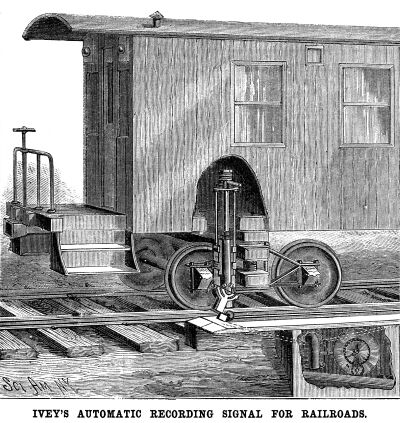AUTOMATIC RECORDING SIGNAL FOR RAILROADS.
Scientific American—April 5, 1890
 A signal for automatically recording
the time of passage of a train past a station, and delivering
any desired message or orders for station agents or employee,
is illustrated herewith, and forms the subject of a patent issued
to Mr. James B. Ivey, of Macon, Ga. A carrier is connected to
the engine, caboose, or one of the cars, and a receiver located
on the road bed at the side of the track, into which signal balls
are automatically dropped by the carrier, the balls being marked
with or containing the instructions or messages to be delivered.
A face plate carried by the truck frame, or by a frame carried
by the axle boxes of the engine, is provided with lugs having
vertical grooves in which .the side flanges or wings of a barrel
may slide up and down, and into the top of this barrel is fitted
an upper pipe or tube passing through a cap or head plate. The
upper end of the carrier barrel projects a little above the floor
of the car to permit signal balls to be conveniently dropped into
it by a conductor or trainman, and the arrangement is such that
the barrel may be held at various heights to keep a swinging striker
and valve device on its lower end at any required distance above
the trip plate of the signal ball receiver. This striker and valve
device is designed to operate by the striker being moved either
forward or backward, but in any case drops only the lowest ball
from the carrier barrel into the receiver. The latter has a ball-catching
trough of considerable length, and a shorter and deeper box into
which the balls pass from the trough, there being in this box
a clockwork mechanism by means of which the exact time of the
dropping of each ball is marked by a prick, punch, or stamp on
a ribbon or band. The signal ball may be made hollow, with one
or more holes communicating with its interior, or in two detachable
parts, to contain reports, orders, etc., or it may be made solid
and marked on its exterior with the desired information, but the
ball receiver is designed to be locked, so that only authorized
persons having a key shall have access thereto. A signal for automatically recording
the time of passage of a train past a station, and delivering
any desired message or orders for station agents or employee,
is illustrated herewith, and forms the subject of a patent issued
to Mr. James B. Ivey, of Macon, Ga. A carrier is connected to
the engine, caboose, or one of the cars, and a receiver located
on the road bed at the side of the track, into which signal balls
are automatically dropped by the carrier, the balls being marked
with or containing the instructions or messages to be delivered.
A face plate carried by the truck frame, or by a frame carried
by the axle boxes of the engine, is provided with lugs having
vertical grooves in which .the side flanges or wings of a barrel
may slide up and down, and into the top of this barrel is fitted
an upper pipe or tube passing through a cap or head plate. The
upper end of the carrier barrel projects a little above the floor
of the car to permit signal balls to be conveniently dropped into
it by a conductor or trainman, and the arrangement is such that
the barrel may be held at various heights to keep a swinging striker
and valve device on its lower end at any required distance above
the trip plate of the signal ball receiver. This striker and valve
device is designed to operate by the striker being moved either
forward or backward, but in any case drops only the lowest ball
from the carrier barrel into the receiver. The latter has a ball-catching
trough of considerable length, and a shorter and deeper box into
which the balls pass from the trough, there being in this box
a clockwork mechanism by means of which the exact time of the
dropping of each ball is marked by a prick, punch, or stamp on
a ribbon or band. The signal ball may be made hollow, with one
or more holes communicating with its interior, or in two detachable
parts, to contain reports, orders, etc., or it may be made solid
and marked on its exterior with the desired information, but the
ball receiver is designed to be locked, so that only authorized
persons having a key shall have access thereto.
Safety Devices
| Contents Page
|







